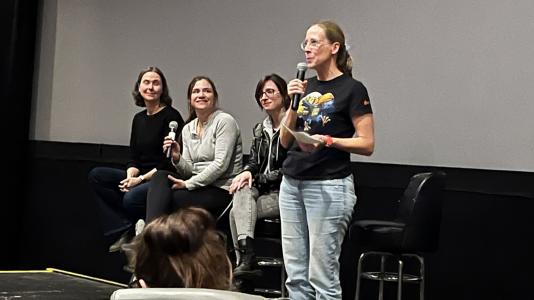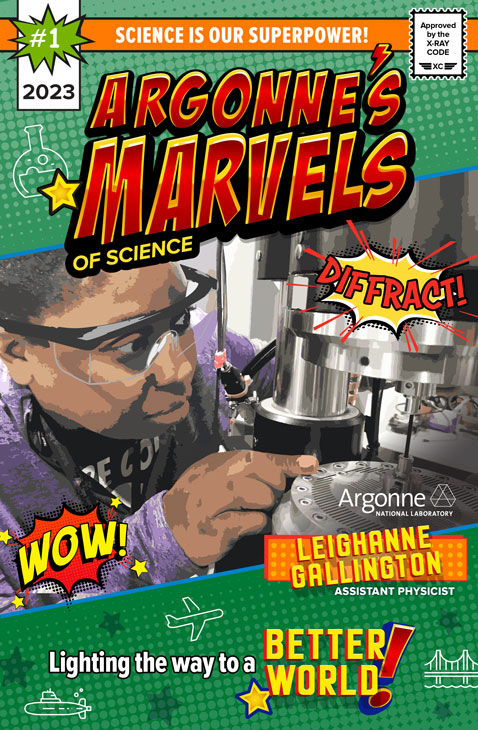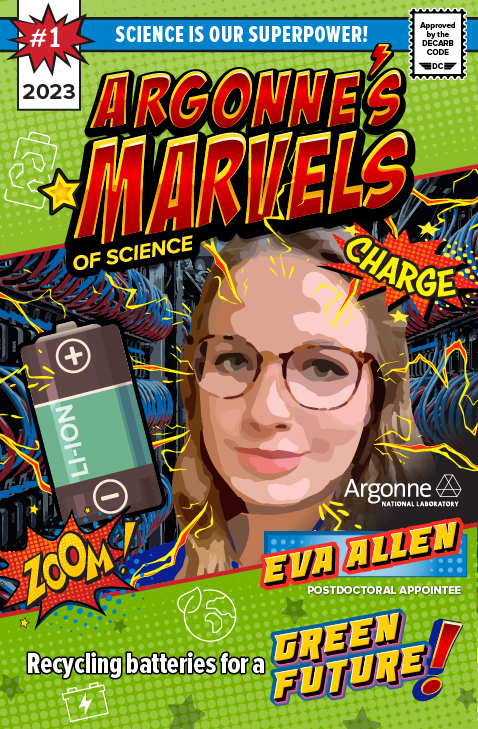Sign up for daily news updates from CleanTechnica on email. Or follow us on Google News!
When Captain Marvel becomes quantum-entangled with two other superheroes, only science can save them, so experts from Argonne and Fermilab set out to untangle the real quantum physics and cosmology concepts behind the movie The Marvels.

Disney’s “The Marvels” are some of the latest comic book heroes blasting across movie screens and streaming channels with high-flying sci-fi feats to save the world. In the film, three heroes with the power of manipulating light find themselves quantum-entangled and then must face off against a threat from beyond the stars.
But real-life heroes much closer to home are using the power of science to make our world safer, cleaner and brighter. At the U.S. Department of Energy (DOE) national labs, our researchers manipulate light to learn more about nature, harness quantum phenomena such as entanglement and explore the secrets of the cosmos.
Recently, moviegoers got the chance to explore the science behind “The Marvels” by joining experts from DOE’s Argonne National Laboratory and Fermi National Accelerator Laboratory for a screening and panel discussion. The panel included cosmologist Ana Botti of Fermilab, physicist and X-ray scientist Jessica McChesney of Argonne, and physicist and beamline controls specialist Fanny Rodolakis of Argonne. Additionally, Rebecca Thompson, head of Fermilab’s Office of Education and Public Engagement, moderated the panel.
“… it’s the perfect entry point to show them the things that are possible when we move beyond sci-fi into all of the amazing things that are actually happening in our national labs.” — Rebecca Thompson, head of Fermilab’s Office of Education and Public Engagement
Audience members young and old got in on the fun, asking questions about whether space-time rips were hexagonal, as depicted in the movie, how parallel universes worked, and whether quantum entanglement could lead to teleportation.
One audience member asked the panel, “What did the movie get right?” McChesney responded, “I don’t watch Marvel movies to see what they get right. I watch them to have fun. But I like that they use real science as a basis for the more fantastic elements of the story because it’s interesting to see where they take the theories.”
“The Marvels” riffs on real research and theoretical concepts in areas such as quantum physics, wormholes and the nature of space-time. Rodolakis agreed with McChesney that with sci-fi, getting it right isn’t always the point. She and Botti pointed out several situations in the movie that could be possible with future scientific discoveries or big leaps in technology. The panelists said they enjoyed the creative jumps the filmmakers made.
“According to what we know or theorize now,” Rodolakis said, “it’s not necessarily right, but it’s not implausible.”
Thompson moderated the panel and loves harnessing the power of pop culture to get people excited about science.
“For people to really understand science, they have to have a personal connection to it,” she said. “People already have that connection to Marvel. They already love it, so it’s the perfect entry point to show them the things that are possible when we move beyond sci-fi into all of the amazing things that are actually happening in our national labs.”
It’s a bird. It’s a plane. It’s more superheroes of super science!
Want to learn more about Argonne’s Marvels of Science? Argonne created six comic book covers highlighting some of the amazing researchers turning science fiction into science fact.

Fanny Rodolakis
“The Controller”
X-ray Science division
Marvel superheroes often have powers, and just as often, they use complex machines to fight evil. From Iron Man’s suit to the S.H.I.E.L.D. helicarrier, technology is a vital element of the Marvel Cinematic Universe. Likewise, large-scale science relies on large-scale machines. Fanny Rodolakis is a mastermind of technology who works in beamline controls at the Advanced Photon Source (APS), a DOE Office of Science user facility at Argonne. Her superpower? A capability to “communicate” with machines, orchestrating their intricate systems to keep the very bright light shining at the beamlines. Scientists use that light to create new materials for roads and bridges, uncover new treatments and vaccines for infectious diseases, and design the next generation of batteries and solar cells. Fanny’s synergy with these behemoth machines is pivotal to scientific advancement. Her dialogue with the machines ensures that the wheel of progress keeps turning.

Leighanne Gallington
“The X-ray Visionary”
X-ray Science division
The three heroes of “The Marvels” — Captain Marvel, Ms. Marvel and Monica Rambeau, who goes by Photon in the comics — all use their powers to manipulate light. Leighanne Gallington is an assistant physicist at Argonne’s APS, a powerful X-ray light source. Leighanne manipulates the super-bright light of the APS to examine even the smallest changes deep within materials with incredible resolution, probing deep into thick materials to learn what secrets are hidden within. Wherever information lurks, Leighanne will harness the light of the APS to find it. Leighanne will use this information to help build safer bridges, tougher submarines, more durable airplane engines, faster-charging batteries — the materials we need to take us to the edge of the universe.

Eva Allen
“The Green Energizer”
Applied Materials division
Marvel superheroes are constantly trying to improve our world. One of the most effective ways to do that, even if you’re not a superhero, is to consider the long-term future of human life on our planet. At Argonne, scientist Eva Allen is building a greener future by developing materials to be used in long-lasting electric vehicle batteries. Using Argonne’s APS, she focuses X-ray beams to create high-resolution 3D images of battery-material samples and study how they would work in an energy storage device. She also uses machine learning and high performance computing to simulate the operations of these batteries. Thanks to Eva, we are headed to a cleaner, greener environment for all.

Jodi Canaday
“The Forensic Identifier”
Strategic Security Sciences
Radiation plays a big part in the origin stories of several Marvel superheroes, from Spider-Man to the Incredible Hulk. In real life, though, radiation is found in nature and in everyday objects, and it’s something to be managed carefully. Jodi Canaday is a principal threat and forensic scientist at Argonne. She strengthens national security by identifying materials that may be sources of radiation. By analyzing forensic signatures, she’s able to identify the material’s manufacturer, age and supply chain. Not only that, but she teaches her skills to others, helping build a global workforce of data analysts, engineers, and scientists that are skilled in radiological security and material identification.

Sarah Owens
“The Sequencer”
Bioscience division
Ms. Marvel, AKA Kamala Khan, is a superfan-turned-superhero. Her mutant genes help her harness the power of the djinn to save the world. In real life, understanding our DNA has helped us unlock secrets of the human body, conquer diseases, understand and protect complex ecosystems, and fend off pandemic-causing viruses. Sarah Owens is one of the people working to unravel the mysteries of DNA. She is the manager of Argonne’s Environmental Sample Preparation & Sequencing Facility. Her work and her lab’s expertise were essential in creating a reliable and scalable system for COVID-19 wastewater monitoring.

Xuedan Ma
“The Quantum Materalist”
Nanoscience and Technology division
In “The Marvels,” Captain Marvel, Ms. Marvel and Monica Rambeau find themselves entangled with one another, switching places as they use their superpowers. Quantum entanglement is not mere fantasy. In real life, scientists exploit the phenomenon to enable quantum computing, communication and cryptography — technologies that are expected to have profound impacts on areas as varied medicine, logistics and finance in the coming decades. Quantum information is encoded in packets called qubits, and at Argonne, scientist Xuedan Ma is creating high-performance materials that host long-lasting qubits. By manipulating materials at the nanoscale, Xuedan is enabling technologies of the future.
About the Advanced Photon Source: The U. S. Department of Energy Office of Science’s Advanced Photon Source (APS) at Argonne National Laboratory is one of the world’s most productive X-ray light source facilities. The APS provides high-brightness X-ray beams to a diverse community of researchers in materials science, chemistry, condensed matter physics, the life and environmental sciences, and applied research. These X-rays are ideally suited for explorations of materials and biological structures; elemental distribution; chemical, magnetic, electronic states; and a wide range of technologically important engineering systems from batteries to fuel injector sprays, all of which are the foundations of our nation’s economic, technological, and physical well-being. Each year, more than 5,000 researchers use the APS to produce over 2,000 publications detailing impactful discoveries, and solve more vital biological protein structures than users of any other X-ray light source research facility. APS scientists and engineers innovate technology that is at the heart of advancing accelerator and light-source operations. This includes the insertion devices that produce extreme-brightness X-rays prized by researchers, lenses that focus the X-rays down to a few nanometers, instrumentation that maximizes the way the X-rays interact with samples being studied, and software that gathers and manages the massive quantity of data resulting from discovery research at the APS.
This research used resources of the Advanced Photon Source, a U.S. DOE Office of Science User Facility operated for the DOE Office of Science by Argonne National Laboratory under Contract No. DE-AC02-06CH11357.
Argonne National Laboratory seeks solutions to pressing national problems in science and technology. The nation’s first national laboratory, Argonne conducts leading-edge basic and applied scientific research in virtually every scientific discipline. Argonne researchers work closely with researchers from hundreds of companies, universities, and federal, state and municipal agencies to help them solve their specific problems, advance America’s scientific leadership and prepare the nation for a better future. With employees from more than 60 nations, Argonne is managed by UChicago Argonne, LLC for the U.S. Department of Energy’s Office of Science.
The U.S. Department of Energy’s Office of Science is the single largest supporter of basic research in the physical sciences in the United States and is working to address some of the most pressing challenges of our time. For more information, visit https://energy.gov/science.
Courtesy of Argonne National Labatory.
Have a tip for CleanTechnica? Want to advertise? Want to suggest a guest for our CleanTech Talk podcast? Contact us here.
Latest CleanTechnica TV Video
I don’t like paywalls. You don’t like paywalls. Who likes paywalls? Here at CleanTechnica, we implemented a limited paywall for a while, but it always felt wrong — and it was always tough to decide what we should put behind there. In theory, your most exclusive and best content goes behind a paywall. But then fewer people read it!! So, we’ve decided to completely nix paywalls here at CleanTechnica. But…
Thank you!
CleanTechnica uses affiliate links. See our policy here.




